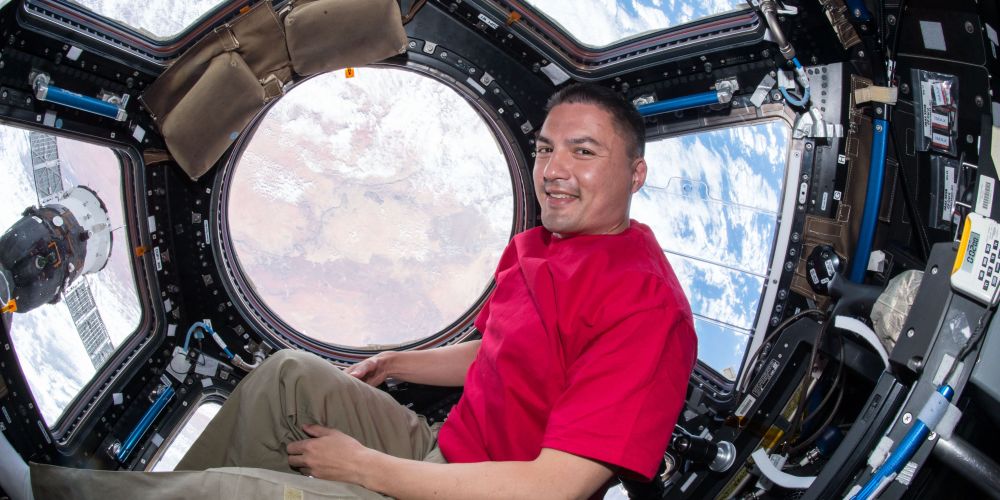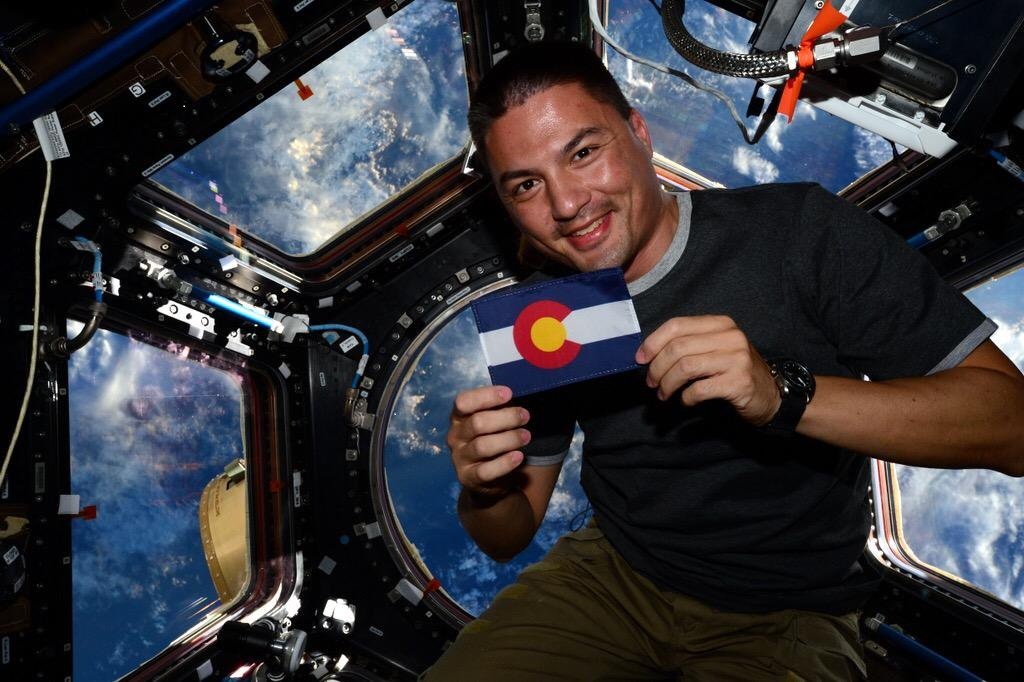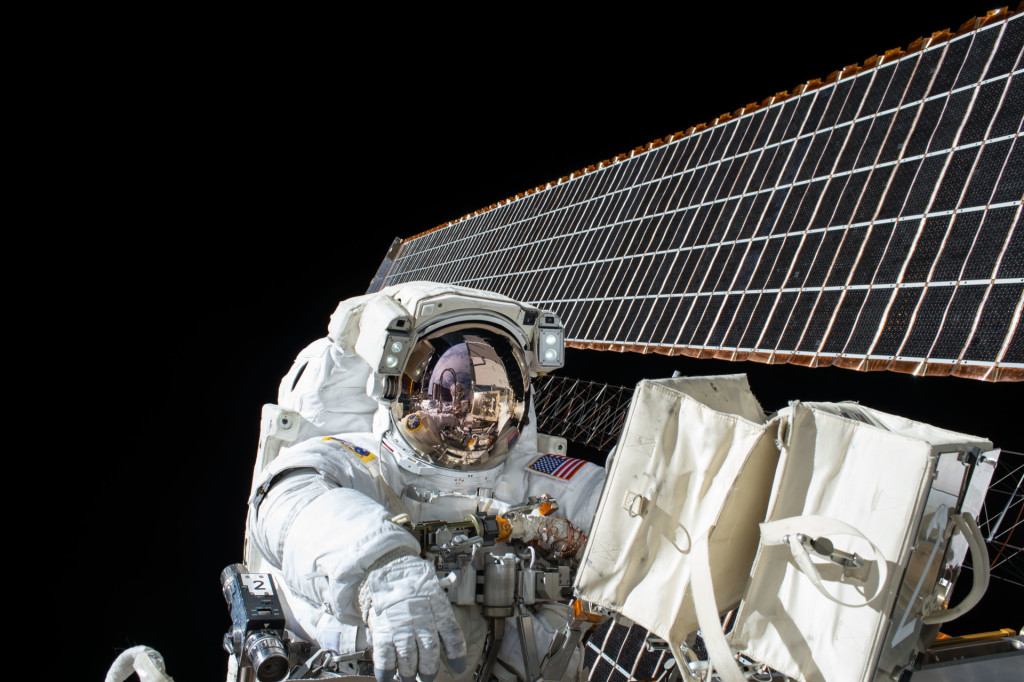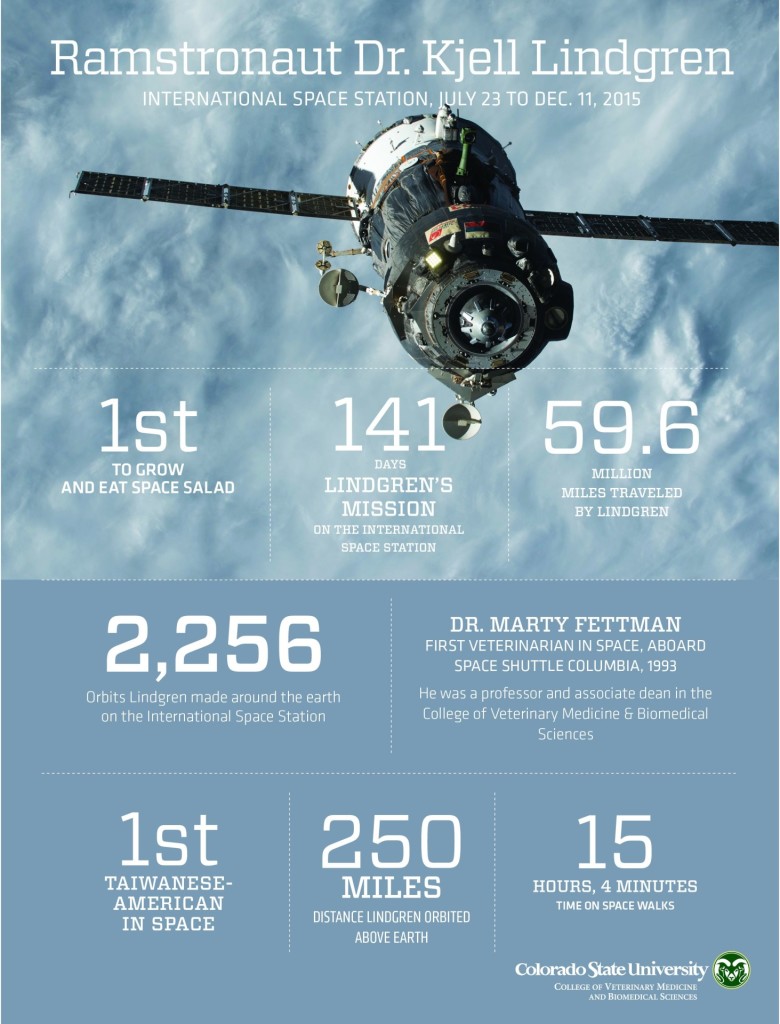
Dr. Kjell Lindgren, CSU alumnus, was selected as an astronaut in June 2009 as one of 14 members of the 20th NASA astronaut class. He subsequently flew on Expedition 44/45 and logged 141 days in space. Photo: NASA
During six months in 2015, he juggled oranges, ate a salad, took a couple walks, and fixed a toilet.
Regular stuff. Except Dr. Kjell Lindgren did it all in space.
As flight engineer on International Space Station Expeditions 44 and 45, the astronaut and Colorado State University alumnus spent 141 days in orbit and logged 15 hours and 4 minutes on two spacewalks.
Lindgren will return to campus March 22 to share his experiences as a NASA astronaut on the International Space Station, including conducting research in the orbiting national laboratory, eating the first lettuce grown in space, playing the bagpipes, and performing plumbing repairs. Lindgren also was a crewmate of astronaut Scott Kelly, who just completed a yearlong mission in space and, with his twin brother here on Earth, is part of NASA’s famous “Twins Study.”
The theme of Lindgren’s CSU visit is “The View from Space.” During a keynote address, he will show video and photos from his six months on the International Space Station, followed by an audience question-and-answer session. The talk is free and open to the public; it begins at 6 p.m. March 22 in the Lory Student Center Theatre.
From space walks to campus talks
“It’s a great opportunity for me to come back to one of the places that really built the foundation for my education to get to where I am today,” said Lindgren from Houston, where he lives with his family and works at NASA. “I get to share the larger, extraordinary journey that got me to the space station. Lots of teachers and professors walked alongside me on that journey.”
The View from Space
Dr. Kjell Lindgren, CSU alumnus and NASA astronaut
For Research Faculty
A Galaxy of NASA Investigations
10 a.m. Tuesday, March 22
Lory Student Center, Room 382
Register here
Just for Students
Reach for the Stars with Science & Medicine
11:30 a.m. Tuesday, March 22
Lory Student Center, Room 382
Free lunch!
Register here
Keynote
Six Months on the International Space Station
6 p.m. Tuesday, March 22
Lory Student Center Theatre
Free and open to the public
Register here
From his walk along the exterior of the space station, he will return to walk the CSU Oval, spending the day on campus and speaking to students and faculty about his path to NASA.
He’s looking forward to seeing C.W. Miller, the biomedical sciences professor he surprised with a phone call from the space station in September.
Just call him “Space Doctor”

Lindgren, 43, earned a master’s degree in cardiovascular physiology from Colorado State in 1996, after receiving his bachelor’s degree in biology with a minor in Mandarin Chinese from the U.S. Air Force Academy in 1995. He completed a medical degree at the University of Colorado in 2002, and went on to a two-year residency in aerospace medicine and a master’s degree in public health at the University of Texas Medical Branch in Galveston, Texas. He is board-certified in emergency and aerospace medicine.
All space station crew members are trained in basic medical procedures. For instance, they draw their own blood for the many NASA research projects geared toward preparing humans for long-duration space travel, such as a journey to Mars. But Lindgren was the only “space doctor” on his recent mission.
“We are all really jacks of all trades. I laid cable, fixed the toilet, drew my own blood, we all get pretty good at that,” Lindgren said.
Some of those samples – along with blood from astronaut Scott Kelly – made their way to Susan Bailey’s CSU lab as part of NASA’s Twins Study, which examines the effects of long-term space travel by comparing the cells of twin astronauts Scott and Mark Kelly.
Research paving the way to Mars

Bailey’s work is one of 10 NASA-funded studies on the twins. Her research examines how space radiation changes the astronauts’ telomeres, the tips of DNA molecules that serve as markers of aging. Scott Kelly returned from 340 days in space at 11:26 p.m. EST on March 1, along with Russian cosmonauts Mikhail Kornienko and Sergey Volkov. Kelly’s brother Mark, a former astronaut, remained on Earth as the control subject.
“Telomeres are a biomarker of stresses, including radiation exposure. So the questions we are looking at include, ‘Are astronauts aging more quickly, more prone to dementia, cardiovascular disease, cancer?’” said Bailey, a professor and cancer molecular biologist in the Department of Environmental and Radiological Health Sciences.
Bailey’s lab received pre-flight, in-flight and post-flight blood samples. The in-flight samples were taken on the space station, frozen, and shipped back to Earth via the SpaceX Dragon cargo vehicle, and can reach the lab within 48 hours after the vehicle lands.
Blood samples come off first
When the Soyuz TMA-18M landed in Kazakhstan, some of the first cargo unloaded were fresh blood samples taken on the station just before the return flight. By the time Kelly is jumping into his pool back home in Houston, his blood will have arrived at Bailey’s laboratory in the Molecular and Radiological Biosciences Building.
“I was very excited that we had a CSU research project that I got to participate in,” said Lindgren, whose blood is also stored in a freezer in Bailey’s lab. “Scott Kelly is a tremendous crew member and terrific mentor. This is a critical piece of our journey to Mars.”
